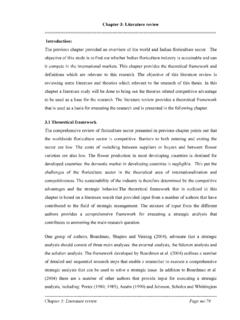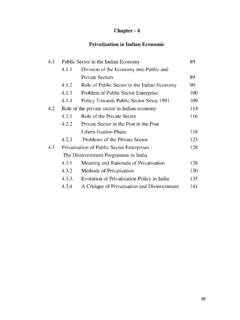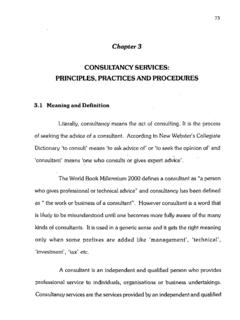Transcription of CHAPTER 2 CREDIT MANAGEMENT A CONCEPTUAL …
1 71 CHAPTER 2 CREDIT MANAGEMENT A CONCEPTUAL FRAMEWORK Introduction Concept of CREDIT CREDIT Definitions Characteristics of CREDIT Types of CREDIT CREDIT Classification CREDIT Instruments Advantages of CREDIT Disadvantages of CREDIT Role of CREDIT in Economy Concept of CREDIT MANAGEMENT Principles of Sound Lending Formulation of Loan Policy Administration of CREDIT Influencing Factors of Loan Policy Evaluation of Applicant CREDIT Monitoring Organization of Bank Lending (A Flow Chart) CREDIT Process (A Flowchart) Loan Pricing Classification of Securities Concept of CREDIT Risk MANAGEMENT CREDIT Risk Rating Basel II (Accord) An NPA Concept 72 The RBI Directives on Advances Various CREDIT Committees Priority Sector Lending Conclusion 73 INTRODUCTION: Every country has to undergo from the continuous process of development.
2 Banks play a vital role in this process. The Indian banking system has progressed as a powerful mechanism of planning for economic growth. Banks channelize savings to investments and consumption. Through that, the investment requirements of savers are reconciled with the CREDIT needs of investors and consumers. 1 Out of all principal roles of the banks, lending is the most important role in which banks provide working capital to commerce and industry. Importance of CREDIT is not only because of its social obligation to cater the CREDIT needs of different sections of the community but also because lending is the most profitable activity, as the interest rates realized on business loans have always been well above those realized on investments.
3 CREDIT being the principal source of income for banks and usually represents one of the principal assets of the banks so its proper MANAGEMENT becomes all the more necessary. The extension of CREDIT on sound basis is therefore very essential to the growth and prosperity of a bank. With the increasing role of commercial banking in capital formation, employment generation and production facilitation, the CREDIT operations of commercial banks are expected to be in harmony with the requirements of the economic system. Till today, banks are the major suppliers of working capital to the trade and industry and they have privilege of having massive lending facilities produced by the banks.
4 Hence, the MANAGEMENT of bank CREDIT operations is required to be more creative than the traditional approach followed by it earlier. 2 Lending activities of banks have surround effect on the economy. For overall development of economy, all the sectors of economy should be grown and developed equally. CREDIT MANAGEMENT serves the concept of CREDIT deployment that bank should observe that overall bank CREDIT should be deployed in such a way that each and every segment of an economy and system of nation get benefited. This is the one aspect of CREDIT MANAGEMENT . On the other hand, if lending activity becomes fail, it adversely affects the whole economy.
5 In last decade, banks have realized that an increase in retail CREDIT increased the CREDIT risk also. Success of bank lies on profitability and liquidity and that come 74 majority from successful lending activity. So an examination of some of the important aspects of CREDIT MANAGEMENT of Indian banks would provide an insight into the CREDIT / lending activity of commercial bank. CONCEPT OF CREDIT : The word CREDIT has been derived from the Latin word credo which means I believe or I trust , which signifies a trust or confidence reposed in another person. The term CREDIT means, reposing trust or confidence in somebody. In economics, it is interpreted to mean, in the same sense, trusting in the solvency of a person or making a payment to a person to receive it back after some time or lending of money and receiving of deposits In other words, the meaning of CREDIT can be explained as, A contractual agreement in which, a borrower receives something of value now and agrees to repay the lender at some later date.
6 The borrowing capacity provided to an individual by the banking system, in the form of CREDIT or a loan. The total bank CREDIT the individual has is the sum of the borrowing capacity each lender bank provides to the individual. CREDIT DEFINITIONS: 1. Prof. Kinley: By CREDIT , we mean the power which one person has to induce another to put economic goods at his deposal for a time on promise or future payment. CREDIT is thus an attribute of power of the borrower. 2. Prof. Gide: It is an exchange which is complete after the expiry of a certain period of time . 3. Prof. Cole: CREDIT is purchasing power not derived from income but created by financial institutions either as on offset to idle income held by depositors in the bank or as a net addition to the total amount or purchasing power.
7 75 4. Prof. Thomas: The term CREDIT is now applied to that belief in a man s probability and solvency which will permit of his being entrusted with something of value belonging to another whether that something consists, of money, goods, services or even CREDIT itself as and when one may entrust the use of his good name and reputation. On the basis of above definitions it can be said that CREDIT is the exchange function in which, creditor gives some goods or money to the debtor with a belief that after sometime he will return it. In other words Trust is the CREDIT .4 5. Vasant Desai: To give or allow the use of temporarily on the condition that some or its equivalent will be returned.
8 5 CHARACTERISTICS OF CREDIT : Some characteristics of CREDIT are of prime importance while extending CREDIT to an individual or to a business enterprise. 1. Confidence: Confidence is very important for granting or extending any CREDIT . The person or authority must have confidence on debtor. 2. Capacity: Capacity of the borrower to repay the debt is also very crucial thing to be considered. Before granting or extending any advance, creditor should evaluate the borrower s capacity. 3. Security: Banks are the main source of CREDIT . Before extending CREDIT , bank ensures properly about the debtor s security. The availability of CREDIT depends upon property or assets possessed by the borrower.
9 4. Goodwill: If the borrower has good reputation of repaying outstanding in time, borrower may be able to obtain CREDIT without any difficulty. 76 5. Size of CREDIT : Generally small amount of CREDIT is easily available than the larger one. Again it also depends on above factors. 6. Period of CREDIT : Normally, long term CREDIT cannot easily be obtained because more risk elements are involved in its security and repayments. 6 FEATURES OF COMMERCIAL BANK CREDIT : 1. Banks provide CREDIT majority to trade and industries than agriculture. Because of the greater risks and inability of agriculturists to furnish good security. 2. The short term loans are given for the seasonal needs and working capital requirements.
10 3. Short term loans may be in the form of cash CREDIT and overdraft, demand loans and the purchase and discount of bills. Among these, cash CREDIT and overdraft are the most popular. 4. Indian banks sanction loans against sound security. 5. Banks take all possible protective steps to minimize their risks while granting loans to the firms. TYPES OF CREDIT : The CREDIT assistance provided by a banker is mainly of two types, one is fund based CREDIT support and the other is non-fund based. The difference between fund based and non-fund based CREDIT assistance provided by a banker lies mainly in the cash out Banks generally allow fund based facilities to customers in any of the following manners.

















